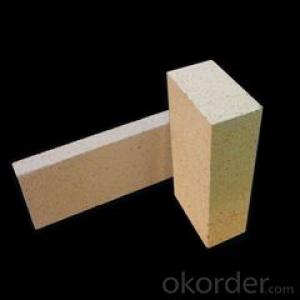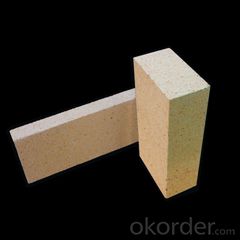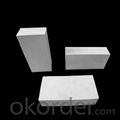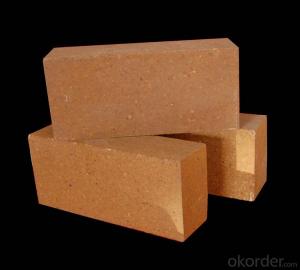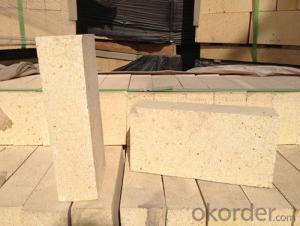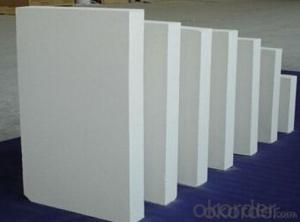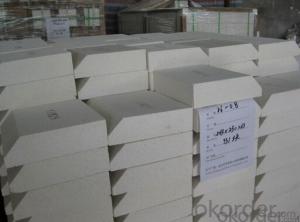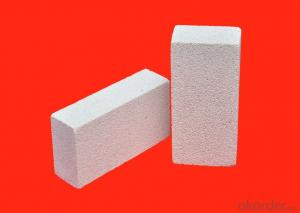Insulating Fire Brick - Mullite Lightweight Refractory White Brick
- Loading Port:
- Shanghai
- Payment Terms:
- TT OR LC
- Min Order Qty:
- 10 m.t.
- Supply Capability:
- 100 m.t./month
OKorder Service Pledge
OKorder Financial Service
You Might Also Like
Quick Details
| Place of Origin: | Brick | Refractoriness (Degree): | Common (1580°< Refractoriness< 1770°) | |
| Brand Name: |
Packaging & Delivery
| Packaging Detail: | 1.fumigated wooden pallet with polyethylene film and steel straps 2.as customers' requirements |
| Delivery Detail: | according to the contracts |
Product Description
Mullite brick is a kind of product made of best quality mullite. This product has features of good
chemical stability, high load softening temperature and good thermal shock stability, etc. It is an important kind of refractory product used in metallurgy, construction material, electric industries, etc.
Sintered Mullite Brick | |||
M-65 | M-75 | M-80 | |
Al2O3 (%) | 65 | 75 | 80 |
Refractoriness (℃) | 1850 | 1850 | 1850 |
Apparent Porosity (%) | 19 | 20 | 21 |
Bulk Density (g/cm3) | 2.5 | 2.6 | 2.7 |
Refractoriness Under Load (℃) | 1580 | 1600 | 1630 |
Atmospheric Pressure Strength(MPa) | 55 | 60 | 60 |
Light Weight Heat Insulation Brick | |||
MD-1300 | MD-1450 | MD-1550 | |
Al2O3 (%) | >40 | >50 | >65 |
SiO2 (%) | 55-60 | 40-50 | 30-35 |
Fe2O3(%) | <1 | <1 | <1 |
Host Lattice | Mullite | Mullite | Mullite |
Thermal Conductivity(w/m.k 400℃) | 0.2-0.3 | 0.2-0.3 | 0.3-0.35 |
Bulk Density (g/cm3) | 0.8-0.9 | 0.8-1.0 | 1.0-1.2 |
Atmospheric Pressure Strength (MPa) | ≥2.5 | ≥3.0 | ≥5.0 |
Refractoriness Under Load (KD℃) | >1300 | >1410 | >1520 |
Safe Working Temperature (℃) | 1300 | 1450 | 1550 |
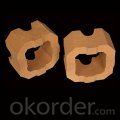
Our Services
1. We will reply to you immediately.
2. Our products will be made according to your index.
3. Other details could be discussed according to customers’ requirements.
FAQ
1. What’s the payment?
Usually T/T, others could be discussed.
2. When will you deliver the goods?
The delivery time will be determined according to the quantity of the order.
3. Do you provide samples?
Yes, samples are available.
4. How are your products’ quality?
The products will be strictly inspected before shipment, so the quality could be guaranteed.
5. Do you accept OEM?
Yes, we can do OEM.
- Q: Can insulating fire bricks be used in the construction of brick ovens?
- Brick ovens can indeed utilize insulating fire bricks. These specialized bricks possess exceptional thermal insulation characteristics, which make them highly suitable for applications that require efficient heat retention, such as brick ovens. Crafted from lightweight refractory materials, these bricks exhibit a lower density compared to standard clay bricks, thereby minimizing heat loss and enhancing energy efficiency. When constructing a brick oven, it is crucial to contemplate the insulation layer responsible for preserving and evenly disseminating heat throughout the oven. Insulating fire bricks can be employed to create this insulation layer, typically positioned between the inner cooking chamber and the outer oven layer. By utilizing these bricks, heat transfer to the outer layer is minimized, preventing excessive heat dissipation and ensuring the oven attains and maintains the desired high temperatures essential for baking or cooking. Apart from their impressive thermal insulation properties, insulating fire bricks also exhibit remarkable resistance to thermal shock. This signifies their ability to endure abrupt temperature changes without cracking or fracturing. This quality is particularly valuable in brick ovens, as they frequently encounter significant temperature fluctuations during the baking process. To sum up, insulating fire bricks are a fitting and highly recommended choice for constructing brick ovens due to their thermal insulation properties, lightweight composition, and resilience to thermal shock. By utilizing these bricks, a well-insulated and efficient oven can be created, capable of achieving and sustaining high temperatures for optimal baking or cooking outcomes.
- Q: Can insulating fire bricks be used in the construction of ladles?
- Insulating fire bricks are indeed suitable for ladle construction. These bricks are crafted from lightweight materials that possess exceptional thermal insulation properties. As a result, they are well-suited for situations where heat retention or control is paramount, such as in the creation of ladles for metal or glass industries. By utilizing insulating fire bricks, heat loss can be minimized, energy efficiency can be enhanced, and the desired temperature within the ladle can be maintained. Furthermore, their lightweight composition facilitates easier handling and installation during ladle construction. Consequently, insulating fire bricks are a viable choice for ladle construction, as they furnish the necessary thermal insulation and durability requisite for these high-temperature applications.
- Q: Is sintering insulation brick good or concrete porous brick good?
- As with the expansion screw, it depends on what to connect, and go in is no problem, the key is that the carrying capacity is not very high, if you do steel support, pull and so on, it is recommended to use concrete.
- Q: Can insulating fire bricks be used as a backup insulation in refractory linings?
- Yes, insulating fire bricks can be used as a backup insulation in refractory linings. They are designed to withstand high temperatures and provide excellent thermal insulation properties, making them suitable for this purpose.
- Q: Can insulating fire bricks be used as a structural material?
- Insulating fire bricks are primarily designed to provide thermal insulation in high-temperature environments such as furnaces, kilns, and fireplaces. While they have excellent insulation properties, they are not typically recommended for use as a structural material in load-bearing applications. Insulating fire bricks are made from lightweight refractory materials that are designed to minimize heat transfer. They have low density and are generally not as strong or durable as standard bricks or other structural materials. They are more prone to cracking, especially under heavy loads or mechanical stress. If used as a structural material, insulating fire bricks may not be able to support the weight or withstand the forces that traditional structural materials are designed to handle. This could lead to structural failure, compromising the safety and integrity of the building or structure. It is important to consult with a structural engineer or building professional to determine the appropriate materials for your specific project. They will take into consideration factors such as load requirements, safety regulations, and durability to ensure that the chosen structural materials are suitable and meet the necessary standards. In conclusion, while insulating fire bricks are effective for thermal insulation purposes, they are generally not recommended for use as a structural material due to their lower strength and durability compared to traditional structural materials.
- Q: Can insulating fire bricks be used in aluminum smelting furnaces?
- Indeed, it is possible to utilize insulating fire bricks within aluminum smelting furnaces. The purpose of these bricks is to possess a low thermal conductivity, thus reducing heat losses within the furnace. This characteristic renders them suitable for various high-temperature applications, including aluminum smelting. Additionally, insulating fire bricks exhibit exceptional resistance to thermal shock, enabling them to endure sudden temperature fluctuations that frequently occur during the smelting process. Moreover, their lightweight nature facilitates ease of handling and installation within the furnace. All in all, insulating fire bricks serve as a practical choice for aluminum smelting furnaces, contributing to enhanced energy efficiency and reduced operational expenses.
- Q: Are insulating fire bricks resistant to nitric acid?
- Yes, insulating fire bricks are generally resistant to nitric acid due to their high refractory properties and chemical stability.
- Q: Can insulating fire bricks be used as a refractory lining material?
- Yes, insulating fire bricks can be used as a refractory lining material. Insulating fire bricks are designed to have low thermal conductivity, which means they can effectively insulate against heat transfer. This makes them suitable for applications where high temperatures need to be maintained or controlled, such as in kilns, furnaces, and industrial ovens. Refractory lining materials are used to protect the structure of these high-temperature environments from the extreme heat generated inside. They need to be able to withstand the thermal shocks, chemical reactions, and mechanical stresses that occur during operation. Insulating fire bricks offer excellent thermal insulation properties, as well as high temperature resistance, making them an ideal choice for refractory lining applications. In addition to their insulating properties, insulating fire bricks also have low density, making them lightweight and easier to handle and install. This can be beneficial in applications where weight is a concern or where refractory linings need to be replaced or repaired frequently. It is important to note that the specific type and composition of insulating fire bricks may vary, and different applications may require different properties. Therefore, it is essential to consult with a refractory engineer or supplier to ensure the chosen insulating fire bricks are suitable for the specific requirements of the application.
- Q: What are the sizes of lightweight thermal insulation bricks?
- Low iron mullite, high aluminum light insulating refractory brick, diatomite insulating refractory brick. Sizes can be customized for ordinary profiled sizes
- Q: Are insulating fire bricks suitable for insulation in gas turbines?
- Insulating fire bricks are not typically suitable for insulation in gas turbines. While they are excellent for high-temperature insulation applications, such as in furnaces and kilns, gas turbines operate at even higher temperatures and require specialized insulation materials. Gas turbines typically utilize thermal barrier coatings, ceramic fiber blankets, or other advanced insulation materials that can withstand the extreme heat and pressure conditions within the turbine. These materials are specifically engineered to provide excellent thermal insulation while also offering other properties such as erosion resistance, low thermal conductivity, and high mechanical strength. Therefore, while insulating fire bricks have their merits in certain applications, they are not the ideal choice for insulation in gas turbines.
Send your message to us
Insulating Fire Brick - Mullite Lightweight Refractory White Brick
- Loading Port:
- Shanghai
- Payment Terms:
- TT OR LC
- Min Order Qty:
- 10 m.t.
- Supply Capability:
- 100 m.t./month
OKorder Service Pledge
OKorder Financial Service
Similar products
Hot products
Hot Searches
Related keywords
